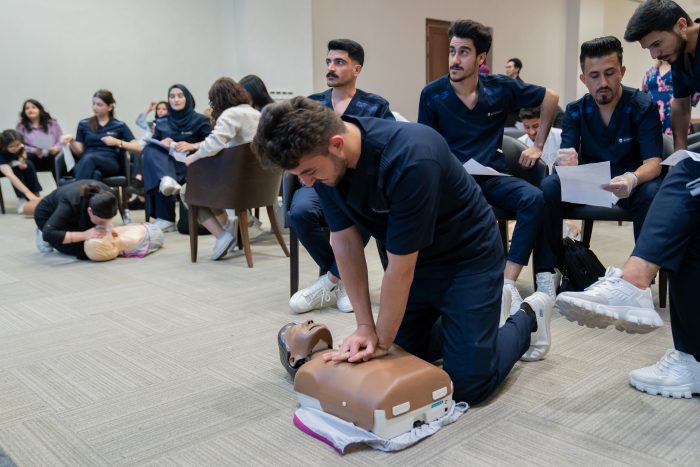On April 26, Dr. Heather Gable and Dr. Kara Platt of Align Nursing Education Consultants once again shared their knowledge and experience with the College of Nursing students of the American University of Kurdistan (AUK). Their sharing of expertise was made possible through a United States Department of State Grant titled "Supporting American-Style Higher Education in Iraq." This time, the topic was Basic Life Support (BLS). The workshop used simulation equipment and videos from the American Heart Association (AHA).
The main topic of the day-long training was CPR (cardio-pulmonary resuscitation). Dr. Gable and Dr. Platt wove back and forth between theory and practice, lecture and conversation, recording and live instruction. One of the initial points was on the ultimate goal of CPR: ROSC (return of spontaneous circulation). In CPR, the firm and frequent chest compressions should go 2 inches/5 centimeters deep; "The science says fast, hard compressions are saving lives," said Dr. Gable. As an AHA video explained, each breath of air a person takes is 21% oxygen and each breath a person gives to another is 17% oxygen, so effective CPR administration approximates autonomous breathing. Students were also advised to watch out for "gastric inflation" (in which air ends up going into the stomach rather than the lungs) and "airway obstructions" (which should be dislodged before attempting CPR).
The practical hands-on experience students had with manikins and machines made this training especially valuable. Students followed instructional videos about compressing the chests of frames big and small, using manikins to simulate both adult and infant sufferers. There are necessary variations figuring to make the difference between life and death; due to the fragility of infants, for instance, proper compressions are executed with two fingers, not with one hand over the other. Students applied pocket masks and barrier devices over the manikins, with which they could blow air more hygienically. As with a real person, the rise of a manikin's chest indicated the successful exchange of air. They also used AED (automated external defibrillator) simulators coupled with bag-mask devices. The AEDs gave the students step-by-step verbal instructions on how to help sufferers. Students worked in groups and rotated their tasks, to emulate the "high-performance teams" commonplace in emergency rooms.
The day's training ended with a two-part test. One part was paper-based, made up of 25 multiple-choice questions on the resuscitation techniques just studied. The other part was practical in design, calling for students to form teams of three and respond to crisis scenarios read aloud by Dr. Gable – first on adult manikins, then on infant ones.



